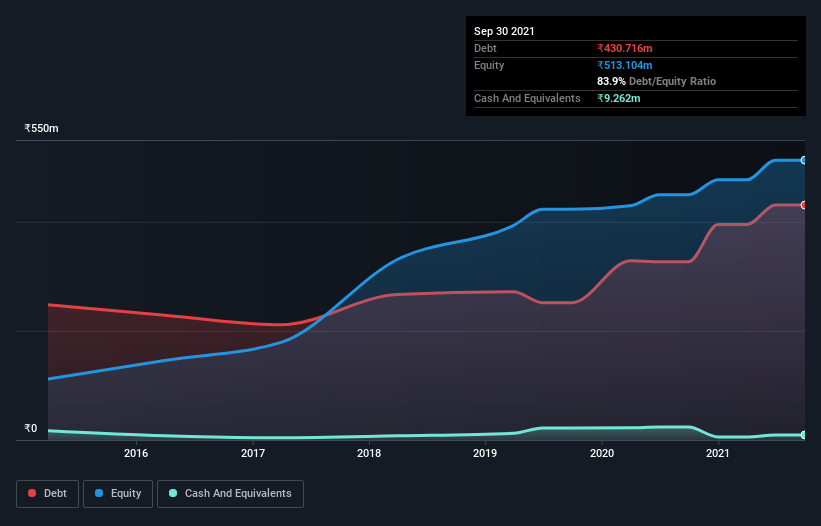We Think Shree Tirupati Balajee FIBC (NSE:TIRUPATI) Is Taking Some Risk With Its Debt
Some say volatility, rather than debt, is the best way to think about risk as an investor, but Warren Buffett famously said that 'Volatility is far from synonymous with risk.' When we think about how risky a company is, we always like to look at its use of debt, since debt overload can lead to ruin. We note that Shree Tirupati Balajee FIBC Limited (NSE:TIRUPATI) does have debt on its balance sheet. But should shareholders be worried about its use of debt?
When Is Debt A Problem?
Generally speaking, debt only becomes a real problem when a company can't easily pay it off, either by raising capital or with its own cash flow. In the worst case scenario, a company can go bankrupt if it cannot pay its creditors. However, a more usual (but still expensive) situation is where a company must dilute shareholders at a cheap share price simply to get debt under control. Of course, debt can be an important tool in businesses, particularly capital heavy businesses. The first step when considering a company's debt levels is to consider its cash and debt together.
See our latest analysis for Shree Tirupati Balajee FIBC
What Is Shree Tirupati Balajee FIBC's Net Debt?
As you can see below, at the end of September 2021, Shree Tirupati Balajee FIBC had ₹430.7m of debt, up from ₹326.8m a year ago. Click the image for more detail. However, it also had ₹9.26m in cash, and so its net debt is ₹421.5m.

How Healthy Is Shree Tirupati Balajee FIBC's Balance Sheet?
The latest balance sheet data shows that Shree Tirupati Balajee FIBC had liabilities of ₹383.2m due within a year, and liabilities of ₹103.6m falling due after that. Offsetting this, it had ₹9.26m in cash and ₹289.9m in receivables that were due within 12 months. So its liabilities outweigh the sum of its cash and (near-term) receivables by ₹187.6m.
This deficit isn't so bad because Shree Tirupati Balajee FIBC is worth ₹474.1m, and thus could probably raise enough capital to shore up its balance sheet, if the need arose. However, it is still worthwhile taking a close look at its ability to pay off debt.
We measure a company's debt load relative to its earnings power by looking at its net debt divided by its earnings before interest, tax, depreciation, and amortization (EBITDA) and by calculating how easily its earnings before interest and tax (EBIT) cover its interest expense (interest cover). This way, we consider both the absolute quantum of the debt, as well as the interest rates paid on it.
With net debt to EBITDA of 3.6 Shree Tirupati Balajee FIBC has a fairly noticeable amount of debt. But the high interest coverage of 7.4 suggests it can easily service that debt. Importantly, Shree Tirupati Balajee FIBC grew its EBIT by 90% over the last twelve months, and that growth will make it easier to handle its debt. There's no doubt that we learn most about debt from the balance sheet. But it is Shree Tirupati Balajee FIBC's earnings that will influence how the balance sheet holds up in the future. So when considering debt, it's definitely worth looking at the earnings trend. Click here for an interactive snapshot.
Finally, while the tax-man may adore accounting profits, lenders only accept cold hard cash. So we clearly need to look at whether that EBIT is leading to corresponding free cash flow. Over the last three years, Shree Tirupati Balajee FIBC saw substantial negative free cash flow, in total. While investors are no doubt expecting a reversal of that situation in due course, it clearly does mean its use of debt is more risky.
Our View
Shree Tirupati Balajee FIBC's conversion of EBIT to free cash flow and net debt to EBITDA definitely weigh on it, in our esteem. But its EBIT growth rate tells a very different story, and suggests some resilience. We think that Shree Tirupati Balajee FIBC's debt does make it a bit risky, after considering the aforementioned data points together. Not all risk is bad, as it can boost share price returns if it pays off, but this debt risk is worth keeping in mind. The balance sheet is clearly the area to focus on when you are analysing debt. However, not all investment risk resides within the balance sheet - far from it. For instance, we've identified 2 warning signs for Shree Tirupati Balajee FIBC that you should be aware of.
Of course, if you're the type of investor who prefers buying stocks without the burden of debt, then don't hesitate to discover our exclusive list of net cash growth stocks, today.
New: Manage All Your Stock Portfolios in One Place
We've created the ultimate portfolio companion for stock investors, and it's free.
• Connect an unlimited number of Portfolios and see your total in one currency
• Be alerted to new Warning Signs or Risks via email or mobile
• Track the Fair Value of your stocks
Have feedback on this article? Concerned about the content? Get in touch with us directly. Alternatively, email editorial-team (at) simplywallst.com.
This article by Simply Wall St is general in nature. We provide commentary based on historical data and analyst forecasts only using an unbiased methodology and our articles are not intended to be financial advice. It does not constitute a recommendation to buy or sell any stock, and does not take account of your objectives, or your financial situation. We aim to bring you long-term focused analysis driven by fundamental data. Note that our analysis may not factor in the latest price-sensitive company announcements or qualitative material. Simply Wall St has no position in any stocks mentioned.
About NSEI:TIRUPATI
Shree Tirupati Balajee FIBC
Manufactures and supplies flexible intermediate bulk containers (FIBCs) and plastic woven sacks in India.
Low risk with questionable track record.
Similar Companies
Market Insights
Community Narratives



